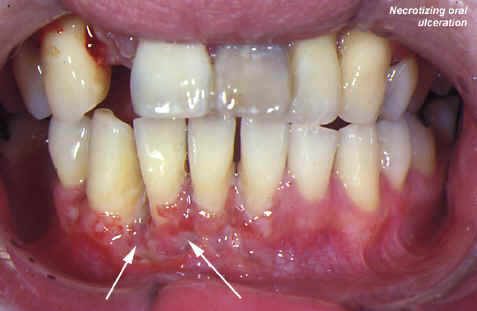

Occasionally, frank septicaemia results from deeper invasion of the tissues and haematogenous spread, and the condition then becomes life threatening.
The condition results from invasion and destruction of the oral tissues by
Gram negative anaerobic bacteria. In terms of its aetiology, the condition is similar to acute necrotizing ulcerative gingivitis, however unlike ANUG, necrotizing ulceration is not confined to the gingivae but can involve any mucosal surface. The lesions may extend to bone. Ulcerations can take on a variety of outlines, but typically are covered by a prominent pseudomembrane, which is dirty grey in colour. The pseudomembrane is not raised above the mucosal surface, but rather covers the area of ulceration.
The lesions are very painful and typically occur in a multiple pattern, unlike the closely related condition of cancrum oris (also known as localised gangrenous stomatitis or noma).
The rapid development of lesions, the invariable presence of lymphadenopathy and systemic signs, and the tendency to persist for extended periods poses significant management problems. The clinical presentation must be differentiated from pseudomembranous candidosis, which can occur simultaneously in immune compromised patients.